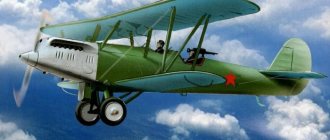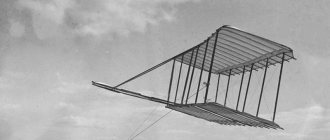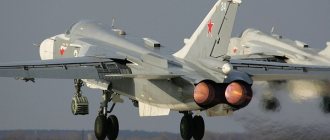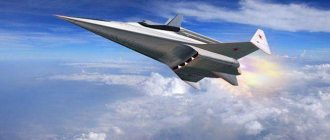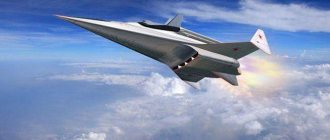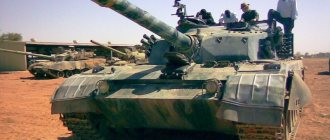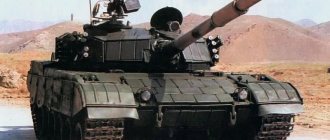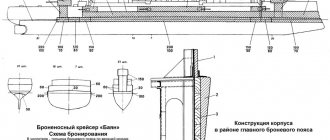Morane-Saulnier Type L reconnaissance aircraft (Moran-Parasol).
Morane-Saulnier Type L reconnaissance aircraft (Moran-Parasol).
Developer: Morane-Saulnier Country: France First flight: 1913
In August 1913, it modified the G-type aircraft, equipping it with a new braced wing mounted above the fuselage (parasol monoplane). This experimental machine became the prototype of the two-seat L-type reconnaissance aircraft, which appeared in 1914, and was a two-seat all-wood parasol monoplane with canvas covering. Developed in 1913 by French aircraft designers, brothers Leon and Robert Moran, together with Raymond Saulnier.
Modification L is the first in a series of Morand-Saulnier aircraft created specifically for military use. The wing raised above the fuselage provided ideal downward visibility, which is important for a reconnaissance officer and artillery observer. It was for this arrangement of the wing that the aircraft received its name (French “parasole” - “umbrella”), which later became a common noun for all devices of a similar design. At the beginning of 1915, ailerons were installed on it. The aircraft, designated "Moran-Saulnier LA", was produced in a small series.
Type L was put into production after receiving an order from Turkey for 50 vehicles. In August 1914, after the outbreak of war, Turkish aircraft were requisitioned by the French government. Powered by 80 hp (60 kW) Gnome or Le Rhone rotary engines, the L-type aircraft entered service with two newly formed squadrons, MS.23 and MS.26. The latter's pilots included the famous Roland Garros. In 1914-1915 the L type was often used as a single-seat, and its armament consisted only of the pilot's pistol or carbine. R. Garros conducted experiments with a machine gun and cut-off device on the L type and, using this device, shot down an enemy airplane on April 1, 1915. Flying a single-seat L-type, Flt-Lieutenant Warenford of the 1st Air Wing of the Royal Navy shot down the Zeppelin LZ 37 of the German Army on June 7, 1915, dropping small bombs on it, causing a fire. But most of the L-type aircraft (of the more than 600 produced) were used by France, Russia and Britain as two-seat reconnaissance aircraft, usually unarmed.
In the Russian Empire, the Morane-Saulnier Type L became one of the most common airplanes in the early stages of the First World War. In total, approximately 450 devices of this type were “handed over to the treasury” at Russian enterprises. More than 400 of them were produced by the Moscow and about 30 by the Petrograd Lebedev plant. Another 100 vehicles were received from France. The front-line service of the Russian Parasols lasted much longer than in the West. The small number of German-Austrian fighters on the eastern front made it possible to use these devices without much risk back in 1917. Quite a few of them were also enrolled in flight schools. In 1916, many Russian Morans were armed with Colt or Vickers synchronized machine guns.
There is no data on the use of Parasols in the Civil War, but it is known that they could be seen at airfields until the mid-twenties.
LTH:
Type: Morane-Saulnier Type L Wingspan, m: 11.20 Length, m: 6.88 Height, m: 3.93 Wing area, m2: 18.30 Engine: 1 x PD “Le Rhone” or “Gnome” - power, hp: 1 x 80 (60 kW) Maximum speed, km/h: 115 Flight duration, hours: 2 Weight, kg - empty, equipped: 385 - maximum take-off: 655 Crew, hours: 2.
Preparing the Morane-Saulnier Type L in the parking lot.
Preparing the Morane-Saulnier Type L in the parking lot.
Option for mounting aerial bombs on the Morane-Saulnier Type L.
Option for mounting aerial bombs on the Morane-Saulnier Type L.
Option for mounting aerial bombs on the Morane-Saulnier Type L.
Morane-Saulnier Type L parked.
Morane-Saulnier Type L parked.
Morane-Saulnier Type L on a ski chassis.
Russian aviator officers at the Morane-Saulnier Type L.
Russian pilots near Morane-Saulnier L.
Russian aviator officers at the Morane-Saulnier Type L. Among the officers is the Russian aviator A.M. Gaber-Vlynsky.
Russian pilots in the Morane-Saulnier Type L.
Cabin Morane-Saulnier Type L.
Morane-Saulnier Type L aircraft parked.
Morane-Saulnier Type L aircraft parked.
Morane-Saulnier Type L aircraft parked.
Morane Saulnier Type L of the red air fleet.
Morane-Saulnier Type L. Drawing.
Armed Morane-Saulnier Type L with bullet cutters on the blades. Drawing.
Morane-Saulnier Type L. Diagram.
.
.
List of sources: A. Sheps. Airplanes of the First World War. Entente countries. Vyacheslav Kondratyev. Fighters of the First World War. Wings of the Motherland. Sergey Gorozhanin. "Moran" - "Giant Killer"
The main modification of "Parasol"
"Moran-Saulnier" L ( MoS .3) - engine "Gnome" (80 hp), "Gnome-Monosupap" (100 hp) or "Ron" 9C (80 hp). Most aircraft were not armed, but those used as fighters received 1 machine gun. Crew - 2 people, when used as a fighter - 1-2 people. The control was carried out by gauging the wing, and later aircraft, designated “Moran-Saulnier” LA, already had ailerons.
Notes[ | ]
- Bruce, 1998, p. 5.
- ↑ 1 2
Herris, Jack.
Pfalz Aircraft of World War
I. Great War Aircraft in Profile, Volume 4. 2001. ISBN 1891268155. P.4-7.20 - ↑ 1 2 3 4 The Illustrated Encyclopedia of Aircraft
1985, p. 2698. - Obuchovich, V., Nikiforov, A. Samolyoty Pyervoy Mirovoy voyny
(Planes of the First World War), Harvest: 2003, ISBN 985-13-1701-2 (Russian), p. 285 - Bruce 1982, p. 291.
Exploitation
Before the war, in many countries of the world, in particular in the USSR, the introduction of new aircraft models into the troops was hampered by the difficulty of retraining pilots who were accustomed to flying old machines.
There was no such problem with Moran. The French pilots mastered this fighter so easily that they did not even need to create training machines. In addition, MS 406 had a low landing speed. However, the car also had significant drawbacks. It showed engine overheating. However, this was a design flaw. The fact is that in order to reach a speed of 450 km/h or more, it was necessary to retract the radiator into the fuselage, and this, in turn, led to overheating of the engine.
Among other design flaws identified during operation, the pilots noted the spontaneous release of the landing gear and radiator during aerobatic maneuvers. At high altitudes, machine guns froze, causing them to stop firing. The machine guns themselves were criticized for having insufficient ammunition due to being magazine fed. The planes did not have armored backs. However, this drawback was eliminated by the pilots themselves.
External links [edit]
| Wikimedia Commons has media related to Moran-Saulnier AI . |
- Old Rhinebeck Airfield page on their original Moran-Saulnier AI (incorrectly labeled as "A-1", archived June 2014)
- Cole Palen flies old Rhinebeck's Moran AI in early August 1990.
| vteMoran-Saulnier plane | |
| Designation letters |
|
| Number sequence |
|
| Names and nicknames |
|

